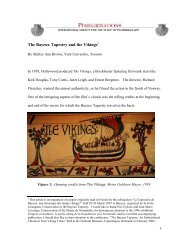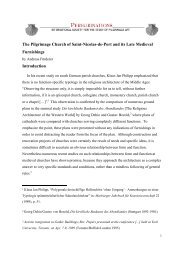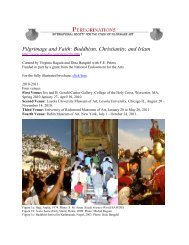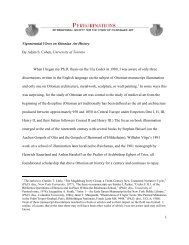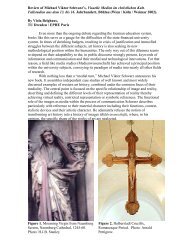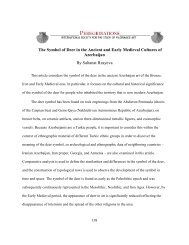The Bayeux Tapestry as a Religious - Peregrinations
The Bayeux Tapestry as a Religious - Peregrinations
The Bayeux Tapestry as a Religious - Peregrinations
You also want an ePaper? Increase the reach of your titles
YUMPU automatically turns print PDFs into web optimized ePapers that Google loves.
decorative styles both in architecture and in manuscript illumination, drawing his inspiration<br />
from both. One of the most profound influences on the artistic world from 1000 to 1300 w<strong>as</strong><br />
Byzantium, with its hieratic forms and austere, boneless figures. Added to this inspiration,<br />
transmuted in the form of precious silks and fabrics, w<strong>as</strong> a Northern flair for decorative arts<br />
incorporating the wonders of nature and the giddy excess of fant<strong>as</strong>tical animals and shapes. This<br />
E<strong>as</strong>tern influence w<strong>as</strong> seen <strong>as</strong> long ago <strong>as</strong> the 1950s and reinterpreted once more in R. Howard<br />
Bloch‟s recent study of the <strong>Tapestry</strong>. 21<br />
Ecclesi<strong>as</strong>tical decoration, both in illuminated manuscripts and in decorative sculpture,<br />
also provided models for the military figures to be found in the <strong>Tapestry</strong>. Musset, in his<br />
introductory chapter, provides an illustration of an early eleventh-century frieze from Winchester<br />
which shows a sword and chain mail that is very similar to that depicted in the <strong>Tapestry</strong>. 22 Some<br />
of the finest examples of carvings of knights in chain mail may be found at the Church of Notre-<br />
Dame-Du-Port at Clermont-Ferrand, dating from around 1150. Line drawings of knights in<br />
armor similar to those depicted in the <strong>Tapestry</strong> may also be seen in manuscripts such <strong>as</strong> the Old<br />
English Hexateuch and scenes from “<strong>The</strong> M<strong>as</strong>sacre of the Innocents.” 23 <strong>The</strong>re are also some fine<br />
carvings of knights to be found at the cathedral and cloister of Monreale, Sicily. <strong>The</strong> roots of<br />
such secular, military, depictions derive, in no small part, from religious sources, which include<br />
both manuscripts and sculpture.<br />
21 Allan Glynne-Jones, Portrait Painters: European Portraits to the End of the Nineteenth Century and English<br />
Twentieth-Century Portraits (London: Phoenix House, 1950); R. Howard Bloch, A Needle.<br />
22 For a photograph of the image, see Lucien Musset, <strong>The</strong> <strong>Bayeux</strong> <strong>Tapestry</strong>, chap. 3, fig. 6.<br />
23 BL MS Cotton Claudius B IV, fol. 24v; BL MS Cotton Nero C 4 f.14,and BL Add MS 14789 f.10. For a<br />
detailed description of the Norman military, see Christopher Gravett, <strong>The</strong> Norman Knight AD 950-1204 (New<br />
York: Osprey Books, 1993).<br />
151



